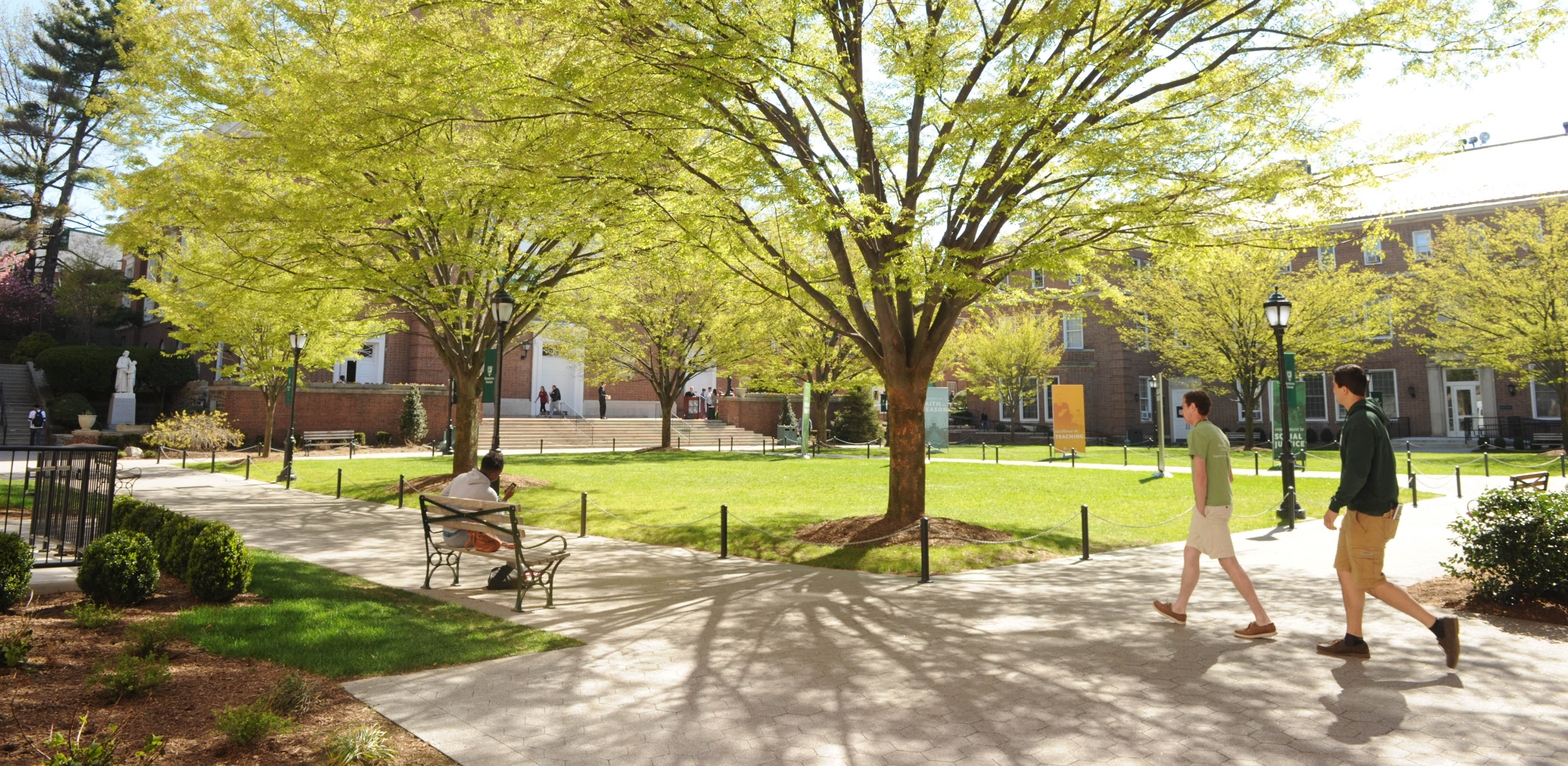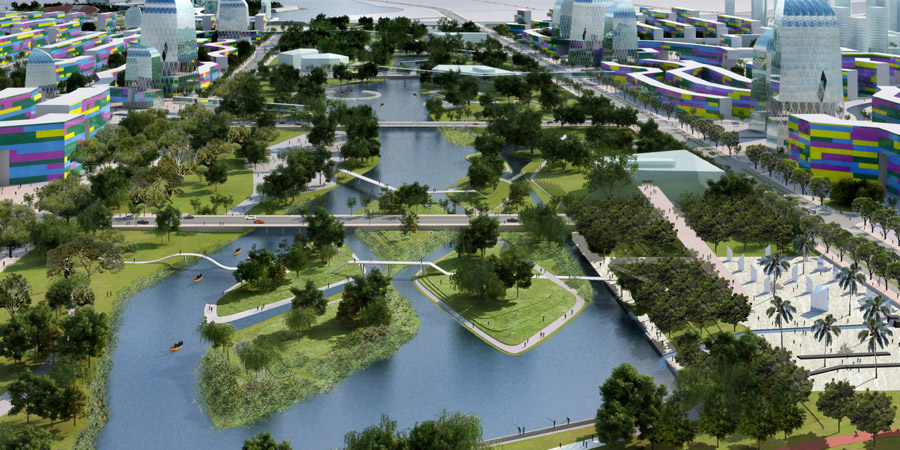Areas of Expertise
 Many Manhattan University faculty members are currently engaged in conducting research, teaching courses, writing papers, or otherwise investigating topics related to sustainability and the mission of CURES. Learn more about the wide-ranging work being done by our faculty:
Many Manhattan University faculty members are currently engaged in conducting research, teaching courses, writing papers, or otherwise investigating topics related to sustainability and the mission of CURES. Learn more about the wide-ranging work being done by our faculty:
-
Urban Ecology
 Urban ecology is more than the study and protection of nature in cities. It is the study of cities as ecological communities in and of themselves. Urban ecology looks at cities both as complex social and ecological systems and places that are uniquely structured for human needs. Consequently, cities are indispensable laboratories of innovation for urban problems. Creative adaptation while living within limits — resilience and sustainability — is key to facing the coming social and environmental challenges of the 21st century. How cities respond to these challenges will promote or detract from the well being of a city’s residents.
Urban ecology is more than the study and protection of nature in cities. It is the study of cities as ecological communities in and of themselves. Urban ecology looks at cities both as complex social and ecological systems and places that are uniquely structured for human needs. Consequently, cities are indispensable laboratories of innovation for urban problems. Creative adaptation while living within limits — resilience and sustainability — is key to facing the coming social and environmental challenges of the 21st century. How cities respond to these challenges will promote or detract from the well being of a city’s residents.Urban Ecology and CURES
CURES is a bridge-builder among stakeholders supporting positive urban ecology interventions in New York and beyond through courses, research, community science and public outreach. Because we are rooted in a university, we can harness the creative energies of our faculty, students and staff to develop sustainable solutions for a broad range of problems. -
Environmental Quality
 Creating a sustainable water purification solution for poor communities in the Philippines: Poor rural communities face the challenge of obtaining clean, drinkable water. One such community is Nagcarlan, Philippines, which is an agricultural town south of Manila that is dense with coconut trees. Our project, which is done with Dr. Susan Gallardo in the Chemical Engineering Department at De La Salle University in Manila, leveraged this abundant material by converting coconut shells to activated carbon, which can be used to remove harmful waterborne pollutants.
Creating a sustainable water purification solution for poor communities in the Philippines: Poor rural communities face the challenge of obtaining clean, drinkable water. One such community is Nagcarlan, Philippines, which is an agricultural town south of Manila that is dense with coconut trees. Our project, which is done with Dr. Susan Gallardo in the Chemical Engineering Department at De La Salle University in Manila, leveraged this abundant material by converting coconut shells to activated carbon, which can be used to remove harmful waterborne pollutants. By housing the materials inside bamboo, which is also abundant in this community, the outcome was an effective, sustainable, and biodegradable water filter that the local citizens can construct independently. Three other communities are currently interested in this technology, prompting us to begin working with their local governments for potential implementation. This work has been funded by the National Collegiate Inventors and Innovators Alliance (NCIIA), the United States Environmental Protection
-
Water Use & Management
Involved Faculty
- Kevin Farley: PhD, Professor of Civil and Environmental Engineering-Expertise in water quality modeling, sediment contamination, bioaccumulation of toxic chemicals, and metals
- James Abulencia: PhD, Assistant Professor of Chemical Engineering-Expertise in chemical engineering and thermodynamics
- Richard Carbanaro: PhD, Adjunct Associate Professor of Civil and Environmental Engineering-Specialized in the field of environmental chemistry and contaminant fate and transport in natural waters, soils and sediments
- Scott Lowe: PhD, Professor of Civil and Environmental Engineering-Expertise in fluid mechanics, hydraulic design and air quality models
- Kirk Barrett: PhD, Assistant Professor of Civil and Environmental Engineering-Expertise in water quality and urban stormwater and nonpoint source pollution control
Books/Book Chapters
- Farley, K.J. “Water Quality and Sustainability of the Hudson River Estuary,” in Water Quality and Sustainability, J.L. Schnoor (ed), Elsevier, Burlington, MA, 2012, (submitted). (FARLEY, KEVIN)
- Barrett, K. R. 2000. Urban stormwater management and nonpoint source pollution control. Standard Handbook of Environmental Science, Health and Technology (J. Lehr, ed.) McGraw-Hill. pp 9.42-76. (BARRETT, KIRK)
Articles
- Abulencia, J.P., Abraham, N., Caraccio, A., Gallardo, S., McDonnell, K., Ruffini, N., Tanala, F. “Sustainability of Water Resources for the Poor.” Consilience: The Journal of Sustainable Development 2010, 155-166. (ABULENCIA, JAMES)
- Barrett, K. R. 1999. Ecological engineering in water resources: The benefits of collaborating with nature. Water International, Journal of the International Water Resources Association. v 24, p182-188. (BARRETT, KIRK)
- Hey, D. L., A. Kenimer and K. R. Barrett. 1994. Water quality improvement by four experimental wetlands. Ecological Engineering. v 3, pp 381-397. (BARRETT, KIRK)
- Barrett, K. R. and W. Goldsmith. 1998. Bioengineered wetlands and ponds in an existing stream channel for stormwater management and ecological enhancement. Engineering Approaches To Ecosystem Restoration: Proceedings of the 1998 Wetlands Engineering & River Restoration Conference (Donald F. Hayes, ed). ASCE. CD-ROM publication. (BARRETT, KIRK)
- Goldsmith, W., K. R. Barrett, M. Larson and W. Lattrell. 1998. Stabilization and restoration of an urban incised channel: Design, construction and monitoring. Engineering Approaches To Ecosystem Restoration: Proceedings of the 1998 Wetlands Engineering & River Restoration Conference (Donald F. Hayes, ed). ASCE. CD-ROM publication. (BARRETT, KIRK)
Projects
- Creating a sustainable water purification solution for poor communities in the Philippines: Poor rural communities face the challenge of obtaining clean, drinkable water. One such community is Nagcarlan, Philippines, which is an agricultural town south of Manila that is dense with coconut trees. Our project, which is done with Dr. Susan Gallardo in the Chemical Engineering Department at De La Salle University in Manila, leveraged this abundant material by converting coconut shells to activated carbon, which can be used to remove harmful waterborne pollutants. By housing the materials inside bamboo, which is also abundant in this community, the outcome was an effective, sustainable, and biodegradable water filter that the local citizens can construct independently. Three other communities are currently interested in this technology, prompting us to begin working with their local governments for potential implementation. This work has been funded by the National Collegiate Inventors and Innovators Alliance (NCIIA), the United States Environmental Protection Agency (EPA), and Department of Science and Technology (DOST) of the Philippines. (ABULENCIA, JAMES)
- Water Desalination using Concrete: Communities adjacent to the ocean have an advantage of being close to an abundant water source if they have the means to desalinate. Methods such as reverse osmosis (RO) are costly, while simple technologies such as boiling is energy and resource intensive. This project, which is done with Dr. Goli Nossoni in the Civil Engineering Department at Manhattan University and Dr. Susan Gallardo in the Chemical Engineering Department at De La Salle University in Manila, aims to use concrete “membranes” coupled with an electric field as a low-cost, energy lean method to desalinate water. The group recently received funding from the United States Environmental Protection Agency (EPA) to develop this technology, and is currently in the experimental phase. (ABULENCIA, JAMES)
- Development of a Screening-Level Model for Metal Contamination in Lakes: Metal contamination from mining operations and other industrial activities is receiving increased attention in regulatory programs both in the United States and Europe. In support of these programs, we have developed a screening-level model (TICKET-UWM) for assessing the combined effects of metal transport, chemical speciation and kinetics on metal toxicity to fish and other aquatic species in lakes. Continuing work on TICKET-UWM is currently being performed to include new descriptions for metal binding to natural organic matter (based on WHAM VI and WHAM VII formulations) and test the applicability of TICKET-UWM at several field sites. (Continued funding is provided though the Robert V. Thomann Fellowship.) (FARLEY, KEVIN)
- Predicting the Fate and Effects of Resuspended Metal Contaminated Sediments: Metal release from contaminated sediments during propeller wash and other strong resuspension events is a particular concern at U.S. Navy facilities and in commercial ports throughout the United States. To help assess potential environmental impacts, we are working with investigators from the University of Michigan and from the U.S. Army Corps of Engineers in developing modeling tools to predict the release and subsequent exposure and effects of metals on fish and other aquatic organisms during resuspension events. Our work is specially focusing on the effects of sediment and water chemistry on the bioavailability of metals before, during and after sediment resuspension events. (Funding is provided through the Department of Defense Strategic Environmental Research and Development Program (SERDP).) (FARLEY, KEVIN)
Courses Offered
- CEEN 401 – Sustainable Water Resource Engineering
- CIVL 407 – Groundwater Resources
- ENVL 406 – Water and Wastewater Treatment
- ENVL 505 – Surface Water Quality Monitoring
- ENVL 507 – Groundwater
-
Lower Hudson Watershed
Involved Faculty
- Kevin Farley: PhD, Professor of Civil and Environmental Engineering-Expertise in
water quality modeling, sediment contamination, bioaccumulation of toxic
chemicals, and metals
Books/Book Chapters
- Farley, K.J. “Water Quality and Sustainability of the Hudson River Estuary,” in Water Quality and Sustainability, J.L. Schnoor (ed), Elsevier, Burlington, MA, 2012, (submitted). (FARLEY, KEVIN)
- Farley, K.J., Wands, J.R., Damiani, D.R., Cooney, T.F. “Transport, Fate and Bioaccumulation of PCBs in the Lower Hudson River,” in The Hudson River Estuary, J.S. Levington and J.R. Waldman (eds), Cambridge University Press, New York, NY, 2006, pp. 368-382. (FARLEY, KEVIN)
- Baker, J.E., Bohlen, W.F., Bopp, R.F., Brownawell, B., Collier, T.K., Farley, K.J., Geyer, W.R., Nairn, R., Rosman, L. “PCBs in the Upper and Tidal Freshwater Hudson River Estuary: The Science behind the Dredging Controversy,” in The Hudson River Estuary, J.S. Levington and J.R. Waldman (eds), Cambridge University Press, New York, NY, 2006, pp. 349-367. (FARLEY, KEVIN)
Articles
- Diamond, M.L., Gandhi, N., Adams, W.J., Atherton, J., Bhavsar, S.P., Bulle, C., Campbell, P.G.C., Dubreuil, A., Fairbrother, A., Farley, K., Green, A., Guinee, J., Hauschild, M.Z., Huijbregts, M.A.J., Humbert, S., Jensen, K.S., Jolliet, O., Margni, M., McGeer, J.C., Peijnenburg, W.J.G.M., Rosenbaum, R., van de Meent, D., Vijver, M.G. “The Clearwater Consensus: The Estimation of Metal Hazard in Fresh Water.” Int J Life Cycle Assess 2010, 15:143–147. (FARLEY, KEVIN)
Projects
- Evaluation of PCB Transport and Fate in the Lower Hudson River: As dredging of PCB-contaminated sediments in the Upper Hudson progresses, there is continued concern of PCB transport and contamination into the Lower Hudson River. Computer models have therefore been developed to evaluate the long-term transport and fate of PCBs in the Lower Hudson River and New York-New Jersey Harbor. Our current work is specially focusing on refinements in model descriptions for hydrodynamic model grid resolution, sediment transport and organic carbon in the mainstem Hudson. Results from the revised model are being used as part of an overall re-assessment for PCB transport and fate in the Lower Hudson River. (Funding is provided through the Hudson River Foundation). (FARLEY, KEVIN)
- Kevin Farley: PhD, Professor of Civil and Environmental Engineering-Expertise in
-
Environment Restoration & Protection
Courses Offered
- ENGG 670 – Pollution Prevention
- CHML 538 – Air Pollution Control
- CHML 574 – Green Engineering Design
- ENVL 315 – Engineering Ecology
- ENVL 410 – Hazardous Waste Design
-
Water Use & Management
-
Environmental Economics
Environmental economics examines the way economists approach environmental problems. It addresses areas such as public goods, policy instruments, tradable pollution permits, and cost-benefit analysis.
Involved Faculty
Dr. Jimena González-Ramírez
-
Environmental Science
 Involved Faculty
Involved Faculty- Michael Judge: PhD, Professor of Biology-Research in water flow, bivalve ecosystem engineers, and sediment and metal toxicology in estuarine crustaceans
Articles/Papers
- Judge, M.L., M.L Botton, and M.G. Hamilton. 2011. Physiological consequences of the supralittoral fringe: microhabitat temperature profiles and stress protein levels in the tropical periwinkle Cenchritis muricatus (Linneaus, 1758). Hydrobiologia, 675: 143-156. DOI: 10.1007/s10750-011-0812-3. (JUDGE, MICHAEL)
- Coen, L.D., B.R. Dumbauld, and M.L. Judge. 2011. Expanding shellfish aquaculture: a review of the ecological services provided by and impacts of native and cultured bivalves in shellfish-dominated ecosystems. Chpt 9 in: Shellfish Aquaculture and the Environment, edited by S.E.Shumway, Wiley-Blackwell, 528p. (ISBN: 978-0-8138-1413-1)(JUDGE, MICHAEL)
- O’Connor, N.J. and M.L. Judge. 2010. Molting of megalopae of the Asian shore crabHemigrapsus sanguineus in intertidal habitats of Northeastern North America. Journal of Experimental Marine Biology and Ecology, 385: 92-97. (JUDGE, MICHAEL)
- Judge, M.L., R. Duell, L. Burriesci, and W. Moarsi. 2009. Life in the supralittoral fringe: microhabitat choice, mobility and growth in the tropical periwinkle Cenchritis (=Tectarius) muricatus (Linneaus, 1758). Journal of Experimental Marine Biology and Ecology, 369: 148–154. DOI:10.1016/j.jembe.2008.11.004 (JUDGE, MICHAEL)
- O’Connor, NJ, Judge, ML, 2004. Molting of fiddler crab Uca minax megalopae: stimulatory cues are specific to salt marshes. Marine Ecology Progress Series. 282: 229-236. (JUDGE, MICHAEL)
- O’Connor, N.J. and M.L. Judge. 1999. Cues in salt marshes stimulate molting of fiddler crab Uca pugnax megalopae: more evidence from field experiments. Marine Ecology Progress Series, 181:131-139.
- Judge, M.L. and S.F. Craig. 1997. Positive flow dependence in the initial colonization of a fouling community: results from in situ water current manipulations. Journal of Experimental Marine Biology and Ecology, 210: 209-222. (JUDGE, MICHAEL)
- O’Connor, N.J. and M.L. Judge. 1997. Flexibility in timing of molting of fiddler crab megalopae: evidence from in situ manipulation of cues. Marine Ecology Progress Series, 146(1-3): 55-60. (JUDGE, MICHAEL)
- Xie, K.Y., D.C. Locke, D. Habib, M. Judge, and C. Kriss. 1997. Environmental chemical impact of recycled plastic timbers used in the Tiffany Street Pier, South Bronx, New York. Resources, Conservation, and Recycling, 21:199-211 (JUDGE, MICHAEL)
- Levinton, J.S., D.E. Martinez, M.M. McCartney, and M.L. Judge. 1995. The effect of water flow on movement, burrowing, and distributions of the gastropod Ilyanassa obsoleta in a tidal creek. Marine Biology 122: 417-424. (JUDGE, MICHAEL)
- Levinton, J.S., M.L. Judge, and J.P. Kurdziel. 1995. Functional differences between the major and minor claws of fiddler crabs (Uca, family Ocypodidae, Order Decapoda, Subphylum Crustacea). Journal of Experimental Marine Biology and Ecology, 193: 147-160.(JUDGE, MICHAEL)
- Judge, M.L., L.D. Coen, and K.L. Heck, Jr. 1993. Does Mercenaria mercenaria encounter elevated food levels in seagrass beds?: results from a novel technique to collect suspended food resources, Marine Ecology Progress Series 92: 141-150. (JUDGE, MICHAEL)
- Levinton, J.S. and M.L. Judge. 1993. The relationship of closing force to body size for the major claw of Uca pugnax (Decapoda: Ocypodidae), Functional Ecology 7: 339-345.(JUDGE, MICHAEL)
- Judge, M.L., L.D. Coen, and K.L. Heck, Jr. 1992. The effect of long-term alteration of in situ water currents on the growth of Mercenaria mercenaria in the northern Gulf of Mexico. Limnology and Oceanography 37: 1550-1559. (JUDGE, MICHAEL)
- Quinn, J.F., C.L. Wolin, and M.L. Judge. 1989. An experimental analysis of patch size, habitat subdivision, and extinction in a marine intertidal snail. Conservation Biology 3: 242-251. (JUDGE, MICHAEL)
- Judge, M.L., J.F. Quinn, and C.L. Wolin. 1988. Variability in recruitment of Balanus glandula (Darwin, 1854) along the central California coast. Journal of Experimental Marine Biology and Ecology 119: 235-251. (JUDGE, MICHAEL)
- Judge, M.L. 1988. The effects of increased drag on Lottia gigantea (Sowerby, 1834) foraging behavior. Functional Ecology 2: 363-369. (JUDGE, MICHAEL)
-
Urban Sustainability
 Involved Faculty
Involved Faculty- Linda Saphan: PhD, Visiting Assistant Professor of Sociology-Expertise and teaching in Urban Studies and Anthropology
- Dart Westphal: Expertise in Urban Sustainability
- Robert Tota: MD, Adjunct Assistant Professor of Chemical Engineering-Public health
-
Julian Silverman, expertise in life-cycle assessment and materials science
-
Urban Planning & Design
Involved Faculty
- Linda Saphan: PhD, Visiting Assistant Professor of Sociology-Expertise and teaching in Urban Studies and Anthropology
- Dart Westphal: Expertise in Urban Sustainability
- Robert Tota: MD, Adjunct Assistant Professor of Chemical Engineering-Public health consultant
Projects
- A Brownfield Opportunities Area (BOA) study for the Harlem River. (WESTPHAL, DART)
- Two borough-wide greenway plans, and a current effort with Pratt Institute on a greenway vision plan for the Harlem River. (WESTPHAL, DART)
- Establishment of a Food Policy Council in Bridgeport, CT which plans to help secure a sustainable and healthy food environment for the city residents, 20% of which are below the federal poverty level. (TOTA, ROBERT)
- A regional planning organization (together with the Bridgeport Department of Health and the Greater Bridgeport Regional Council, a regional planning organization) to bring a public bike-share program to the city. (TOTA, ROBERT)
Courses Offered
- URBN 301 – Special Topic: Urban Sustainability
-
Buildings: Materials and Designs
Involved Faculty
- Poyin Auyeung: PhD, Assistant Professor of Fine Arts-Research in twentieth-century art and architectural history, urbanism, contemporary Chinese art and postcolonial theories
- Nand Jha: PhD, Professor of Mechanical Engineering-Expertise in system dynamics, manufacturing processes, computer aided design, and engineering mathematics and economy
- Edward Musal
- Graham Walker: PhD, Professor of Mechanical Engineering-Expertise in system dynamics, biomechanics, quality engineering, manufacturing, and design
Books/Book Chapters
- Forthcoming book on Green Design and Manufacturing for Sustainability with Taylor and Francis. Forthcoming in 2013. (JHA, NAND)
Articles/Papers
- “Measurement of design feasibility for sustainability”, Proc The 15th World Multi-Conference on Systemics, Cybernetics & Informatics, pp 452-455, July 19-July 22 2nd, 2011, Orlando, Florida. (JHA, NAND)
Courses Offered
- ENGG 674 – Green Engineering Design
- ENGG 676 – Sustainable Material Selection
- ART 402 – Modern Architecture and the Environment: Ecologically Sustainable and Socially Responsible Design (AUYEUNG, POYIN)
- Engineering Economy and Project Management (JHA, NAND)
- Environmental & Safety Issues in Construction for Engineers – includes a segment covering green buildings (MUSAL, EDWARD)
- ENVL 408 – Environmental Engineering Design
-
Environmental Technology
Alternative and Renewable Energy
Involved Faculty
- James Abulencia: PhD, Assistant Professor of Chemical Engineering-Expertise in chemical engineering and thermodynamics
- Graham Walker: PhD, Professor of Mechanical Engineering-Expertise in system dynamics, biomechanics, quality engineering, manufacturing, and design
-
Environmental Policy & Justice
Topics:
-
Environmental Justice & Ethics
Involved Faculty
- Cory Blad: PhD, Assistant Professor of Sociology-Research in Global Political Economy, State Theory, Nationalism and Culture, and Social Movements
- Jeffrey Myers: PhD, Associate Professor of English-Research in Early and Nineteenth-Century American Literature, Environmental Literature, Ecocriticism and Critical Race Studies
- Eoin O’Connell: PhD, Assistant Professor of Philosophy-Expertise in Kant’s practical philosophy, contemporary moral philosophy, and epistemology
- David Shefferman: PhD, Assistant Professor of Religious Studies-Specializes in the history of religion in the Americas
Books
- Myers, Jeffrey. Converging Stories: Race, Ecology, and Environmental Justice in American Literature. Athens: U of Georgia P, 2005.(MYERS, JEFFREY)
Articles and Book Chapters
- Myers, Jeffrey. “Pastoral and Anti-Pastoral in Aaron Douglas’s Aspects of Negro Life.” Essay in a Keener Perception: Ecocritical Approaches to American Art History. University of Alabama Press, 2009.” (MYERS, JEFFREY)
- Myers, Jeffrey. “Ready to Come Home: Teaching African American Literature as Environmental Literature.” Essay in Approaches to Teaching North American Environmental Literature. MLA Publications, 2008. (MYERS, JEFFREY)
- Myers, Jeffrey. “Other Nature: Resistance to Ecoracial Hegemony in Charles W. Chesnutt’s The Conjure Woman.” African American Review (Spring 2003, 37.1). (MYERS, JEFFREY)
- Myers, Jeffrey. “The Anxiety of Confluence: Evolution, Ecology, and Imperialism in Conrad’s Heart of Darkness.” ISLE: Interdisciplinary Studies in Literature and Environment (Summer 2001, 8.2). (MYERS, JEFFREY)
Courses Offered
- ENGL 345 – Environmental Literature and Ecocriticism
- PHIL 399 – Special Topics: Environmental Ethics
- RELS 377 – Religion and Environmentalism
-
Environmental Policy & Politics
Involved Faculty
- Poonam Arora: PhD, Assistant Professor of Management/Marketing-Expertise in Leadership and Organizational Behavior, Strategic Management and Management Independent Study
- Pamela Chasek: PhD, Professor of Government-Research in international environmental policy, international organizations, multilateral diplomacy, bargaining and negotiation and US foreign policy
- Mehnaz Afridi: PhD, Professor of Religious Studies-Research in Interreligious Identity, Diaspora and Transnational Studies, Post-genocide Identity and Feminist post-colonial theory
- Cory Blad: PhD, Assistant Professor of Sociology-Research in Global Political Economy, State Theory, Nationalism and Culture, and Social Movements
Books/Book Chapters
- Chasek, Pamela S. and Lynn M. Wagner. The Road to Rio: Lessons Learned from Twenty Years of Multilateral Environmental Negotiations. New York: Routledge, 2012. (CHASEK, PAMELA)
- Chasek, Pamela S., David L. Downie and Janet Welsh Brown. Global Environmental Politics, fifth edition. Boulder: Westview Press, 2010. (CHASEK, PAMELA)
- Chasek, Pamela S. and Richard Sherman. Ten Days in Johannesburg: A Negotiation of Hope. Cape Town: Struik Publishers, 2004.(CHASEK, PAMELA)
- Chasek, Pamela S. Earth Negotiations: Analyzing thirty years of environmental diplomacy. Tokyo: UNU Press, 2001. (CHASEK, PAMELA)
- Chasek, Pamela S., ed. The Global Environment in the 21st Century: Prospects for International Cooperation. Tokyo: UNU Press, 2000. (CHASEK, PAMELA)
- Chasek, Pamela S. “Sustainable Development in the 21st Century” in Michael Snarr and D. Neil Snarr, eds Introducing Global Issues, fourth edition. Boulder: Lynne Rienner, 2008. (CHASEK, PAMELA)
- Chasek, Pamela S. “International Climate Change Politics: Looking Beyond 2012” in Jonathan Boston, ed. Towards a New Global Climate Treaty: Looking Beyond 2012. Wellington, New Zealand: Institute of Policy Studies, 2007. (CHASEK, PAMELA)
- Chasek, Pamela S. “The Negotiating System of Environment and Development: A ten-year review” in Gunnar Sjöstedt, Elisabeth Corell and Angela Churie Kallhauge, eds.Global Challenges: Furthering the multilateral policy process, Sheffield, UK: Greenleaf Publishing, 2005. (CHASEK, PAMELA)
- Chasek, Pamela S. “Environmental Organizations and Multilateral Diplomacy: A Case Study of the Earth Negotiations Bulletin” in James P. Muldoon, Jr., et al, eds.Multilateral Diplomacy and the United Nations Today, third edition. Boulder: Westview, 2005.(CHASEK, PAMELA)
- Chasek, Pamela S. “The Ozone Depletion Regime,” in Bertram Specter and I. William Zartman, ed. Getting it Done: Post Agreement Negotiations and International Regimes. Washington, DC: United States Institute of Peace Press, 2003. (CHASEK, PAMELA)
- Chasek, Pamela S. “Negotiations on the Convention to Combat Desertification,” in Gunnar Sjöstedt, ed. Professional Cultures in International Negotiation: Bridge or Rift?Lanham, MD: Lexington Books, 2003. (CHASEK, PAMELA)
- Chasek, Pamela S. “Steps Toward Enhanced Parity: Negotiating Capacity and Strategies of Developing Countries,” in Inge Kaul, ed.Providing Global Public Goods: Making Globalization Work for All. New York: Oxford University Press, 2002 (with Lavanya Rajamani).
- Chasek, Pamela S. “Scientific Uncertainty in Environmental Negotiations” in Ho-Won Jeong, ed. Global Environmental Policies. London: Palgrave, 2001. (CHASEK, PAMELA)
- Chasek, Pamela S. “The Story of the UNCED Process” and “The Negotiating System of Environment and Development.” in Gunnar Sjöstedt, Bertram Spector and I. William Zartman, eds. Negotiating International Regimes: Lessons Learned from the United Nations Conference on Environment and Development. London: Graham and Trotman, 1994.(CHASEK, PAMELA)
Articles/Papers
- Arora, P., Peterson, N., Krantz D.H., Harsity, D.J., Reddy, K., (Accepted Manuscript) “To Cooperate or Not to Cooperate: Using New Methodologies and Frameworks to Understand How Affiliation Influences Cooperation in the Present and Future” (ARORA, POONAM)
- Krantz, D., Peterson, N., Arora, P., Milch, K., Orlove, B. (2008) “Individual Values and Social Goals in Environmental Decision Making,” Decision Modeling and Behavior in Uncertain and Complex Environments, Eds. Kugler, T. Smith, J.C., Connolly, T., Son, Y. J., Springer Press (ARORA, POONAM)
- Alamgir, M., and Arora, P., (1991) Providing Food Security for All, New York University Press, NY (ARORA, POONAM)
- Arora, P., Logg, J., Larrick, R., “I’ll Let You Walk All Over Me If It Makes Me Look Good: Role of Identity in Overcompensation and Disengagement in Environmental Social Dilemmas”. Presented at the International Conference on Social Dilemmas, July 2011, and currently under review at a journal. (ARORA, POONAM)
- Authors: Arora, P., Podesta, G.P., Ruiz Toranzo, F., Bert, F., Mendendez, A., & Jobaggy, E. Role Effects in Environmental Coordination: Teammates and Competitors Vary in Focal Points Selected and Outcomes Obtained in Environmental Coordination Dilemmas (under review but with a slightly different title) (ARORA, POONAM)
- Chasek, Pamela S. “Confronting Environmental Treaty Implementation Challenges in the Pacific Islands.” Pacific Islands Policy 6.Honolulu: East-West Center, 2010.(CHASEK, PAMELA)
- Chasek, Pamela. S., “Rethinking the Law and Policy of Protected Areas in a Warming World: Evolving Approaches of American Conservation Organizations” Journal of International Wildlife Law & Policy 15(1) 2012. (CHASEK, PAMELA)
- Chasek, Pamela S., Wafa Essahili, Mariam Akhtar-Schuster, Lindsay C. Stringer and Richard Thomas “Integrated Land Degradation Monitoring and Assessment: Horizontal Knowledge Management at the National and International Levels.” Land Degradation and Development 22(2) 2011: 272-284. (CHASEK, PAMELA)
- Akhtar-Schuster, Mariam, Pamela S. Chsaek, Mary Seely, Lindsay C. Stringer and Richard Thomas. “Improving the Enabling Environment to Combat Land Degradation: Institutional, Financial, Legal and Science-Policy Challenges and Solutions.” Land Degradation and Development 22(2) 2011: 299-312 (with). (CHASEK, PAMELA)
- Chasek, Pamela S. “Creating Space for Consensus: High-Level Globe Trotting into the Bali Climate Change Conference.”International Negotiation 16(1) 2011: 87–108.(CHASEK, PAMELA)
- Chasek, Pamela S. “U.S. Policy in the UN Environmental Arena: Powerful Laggard or Constructive Leader.” International Environmental Agreements: Politics, Law and Economics 7(4). 2007: 363-387. (CHASEK, PAMELA)
- Chasek, Pamela S. “A Comparative Analysis of Multilateral Environmental Negotiations.” Group Decision and Negotiation, 6(5) September 1997. (CHASEK, PAMELA)
- Chasek, Pamela S. “The Convention to Combat Desertification: Lessons Learned for Sustainable Development.” Journal of Environment and Development, 6(2) June 1997.(CHASEK, PAMELA)
Posters/Talks
- Logg, J. L., Arora, P., “Through the green looking glass: Attention and attitude influence environmental behaviors”. Presented as posters at SJDM Conference, November 2010, and SPSP Conference, January 2011. (ARORA, POONAM)
- Integration of decadal climate predictions, ecological models and human decision-making models to support climate-resilient agriculture in the Argentine Pampas. Poster presented at World Climate Research Program, Denver, October 2011 (ARORA, POONAM)
- Authors: Podestá, G., P. Arora, W. Baethgen, F. Bert, V. Brescia, L. Goddard, R. Katz, B. Kirtman, D. Krantz, D. Lema, C. Macal, M. Marino, L. Mearns, M. North, B. Rajagopalan, F. Ruiz Toranzo, C. Saulo, M. Skansi, P. Sydelko, and C. Vera (ARORA, POONAM)
- Arora, P., “Using Behavioral Decision Making as a Tool for Environmental Policy”, Invited Speaker, NY State Agency NYSERDA, Albany, NY, December 2007 (ARORA, POONAM)
Projects
- A parlor meeting in June in the city with Arava Institute representatives, which focused on water and self-sustainability in Bedouin life in Israel, as well as education at the institute. (AFRIDI, MEHNAZ)
Courses
- GOVT 223 – Environmental Politics
- GOVT 325 – Special Topic: Environmental Law
- ENVL 517 and 417 – Environmental Law
- Principles in Public Health
-
Environmental Justice & Ethics